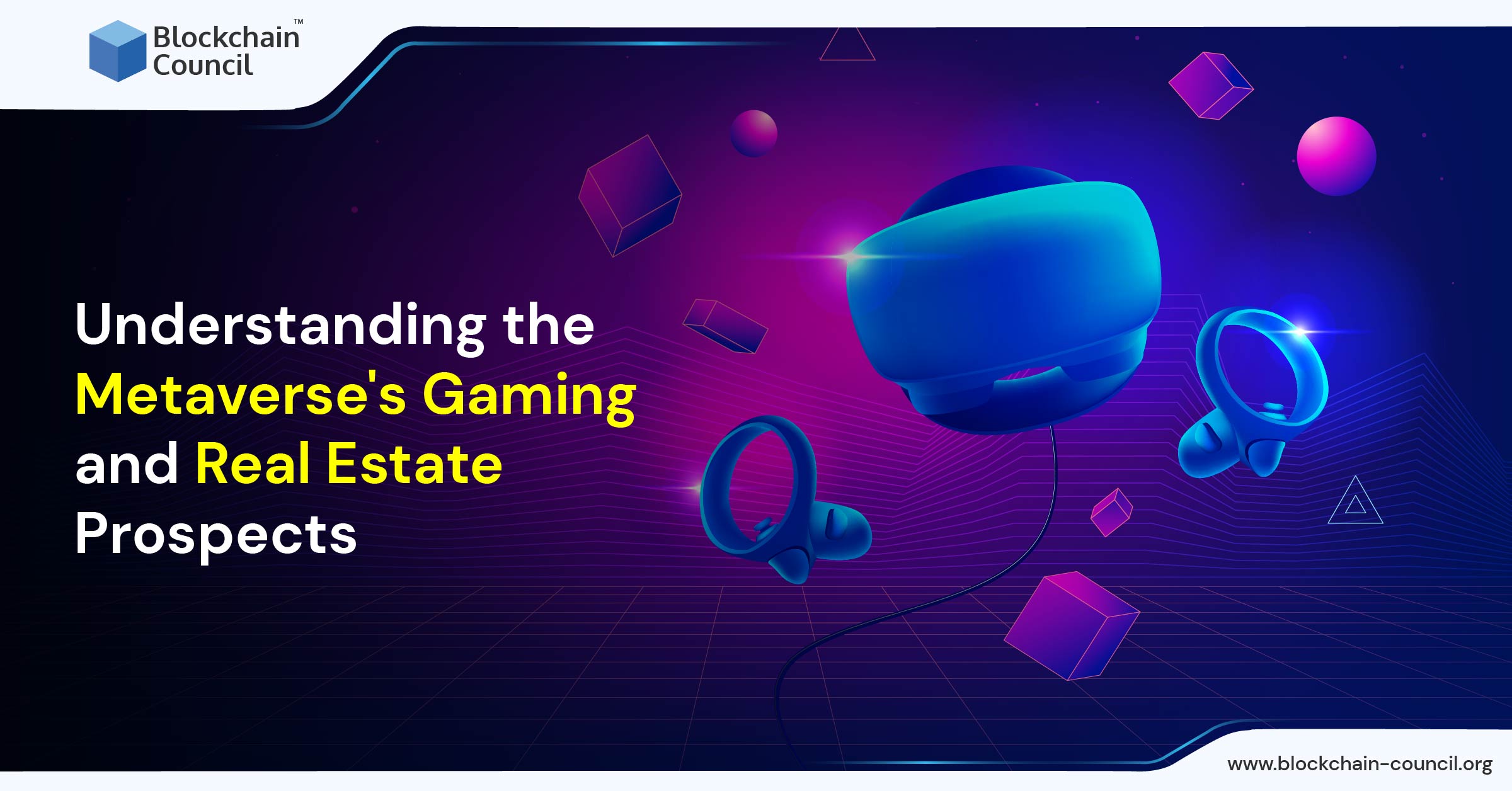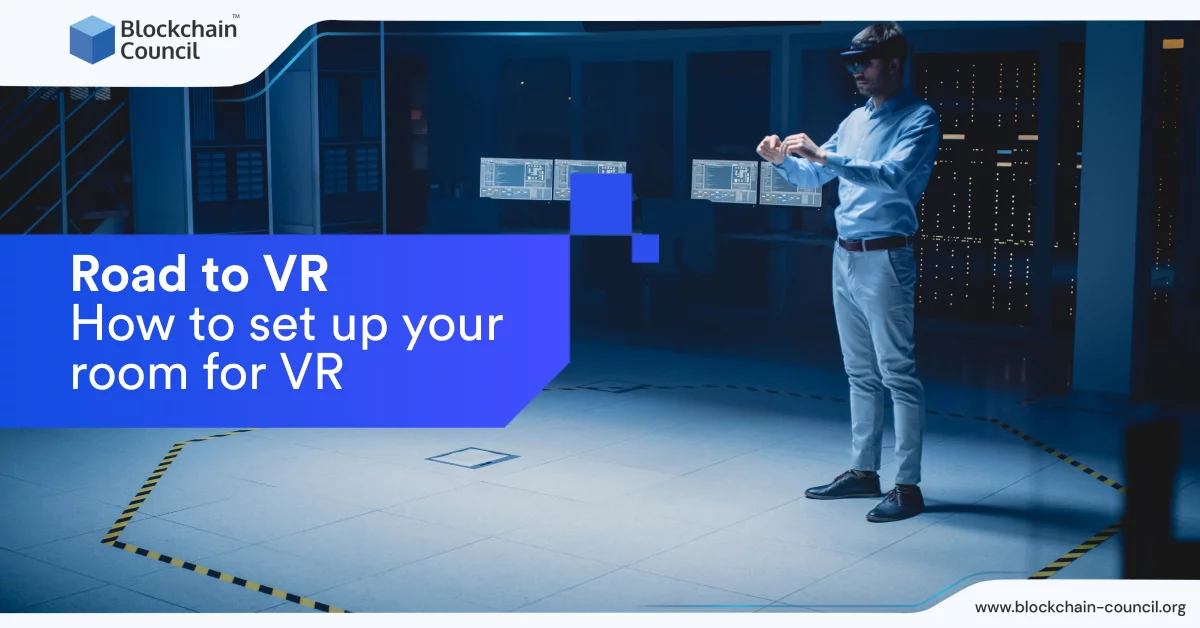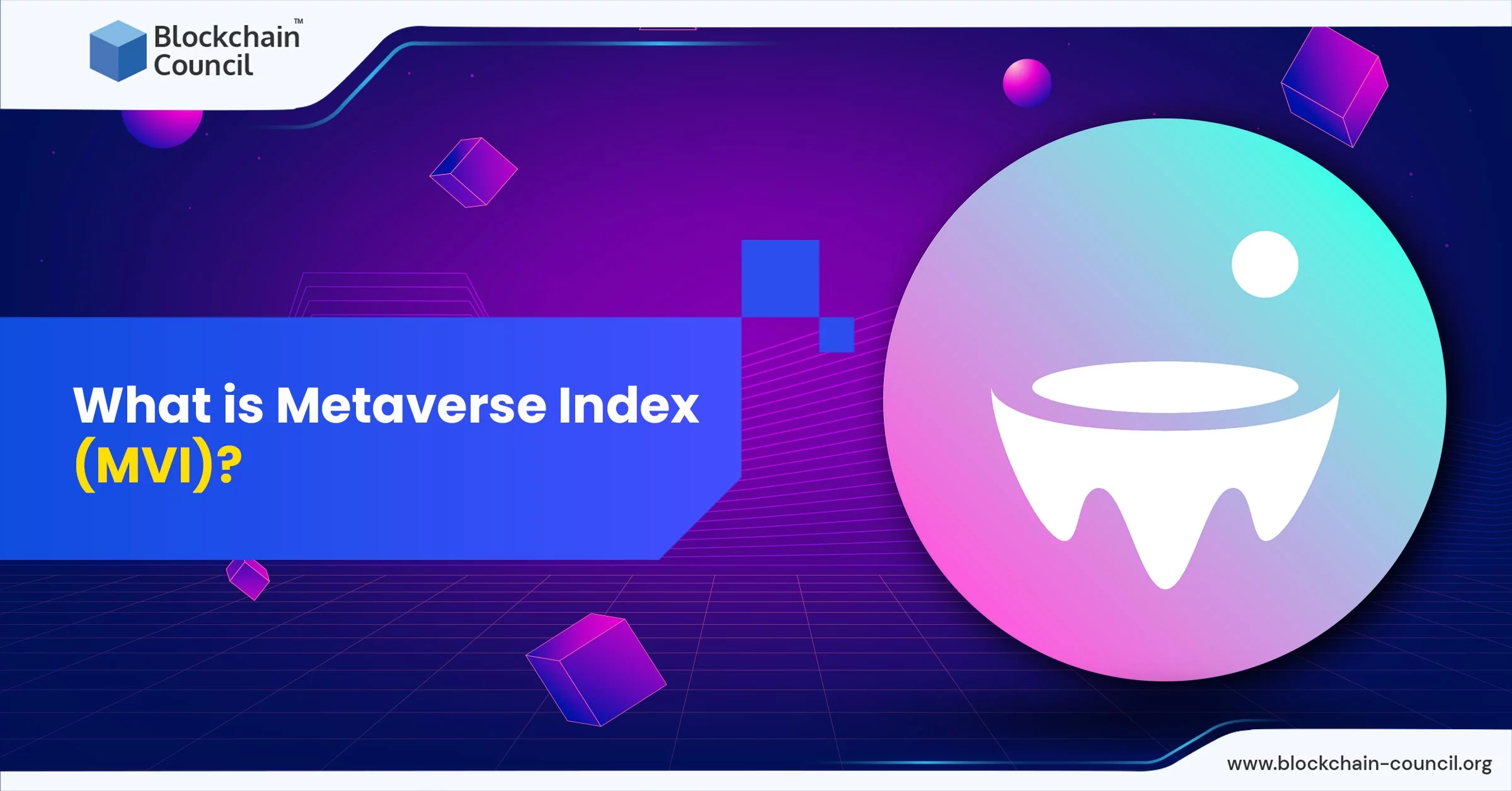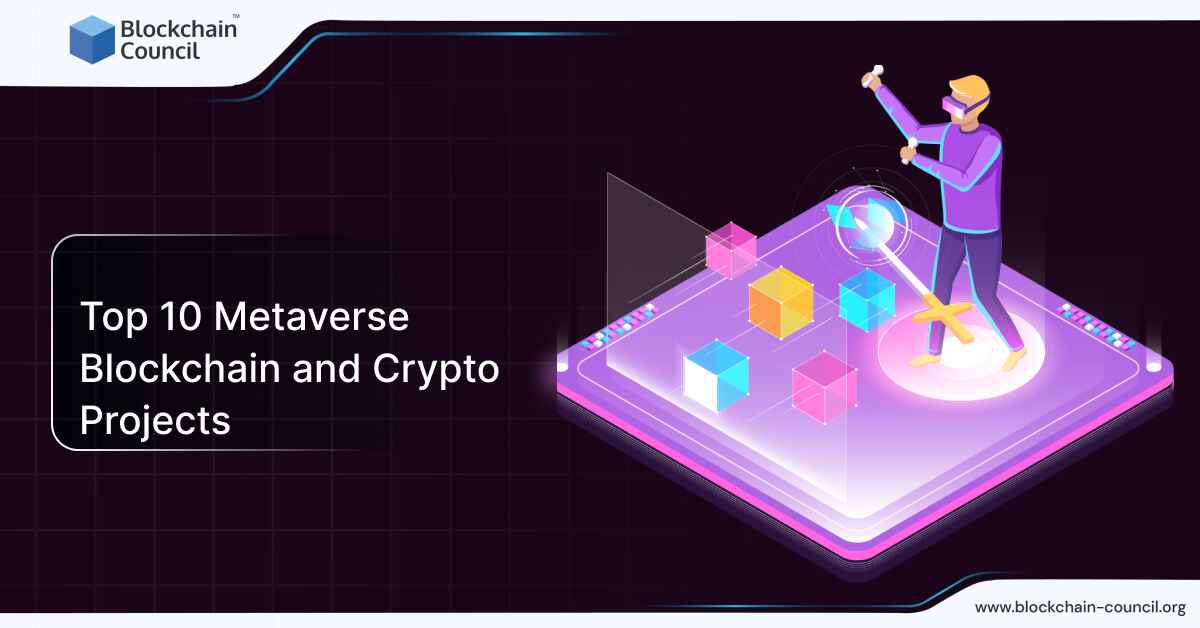
- Blockchain Council
- September 12, 2022
The hype about the metaverse is real and it is slowly creeping into the world of gaming and real estate. As real estate takes advantage of cutting-edge technological advancements like metaverse technologies, gaming is impacted by virtual reality. It follows in the footsteps of other previously speculative technical advancements that have become a reality.
There has been an expansion in the metaverse for a real-time virtual experience in work, education, real estate, and gaming due to the present pandemic condition. By merging different aspects, it transforms the virtual gaming world into a three-dimensional, interactive one. Digital LAND is a non-fungible token (NFT) found in places like Decentraland, Sandbox, and Somnium in the metaverse universe. In recent years, many individuals and institutions have expressed an interest in investing in digital real estate and also adapting VR games.
What is Metaverse?
Metaverse is an online reality created to bring people worldwide together on a single digital platform for socializing and interacting. To create powerful Metaverse interpretations, companies are employing cutting-edge technologies like 3D reconstruction, augmented reality, virtual reality, the Internet of Things, artificial intelligence, and the metaverse blockchain in their assignments.
People are most attracted to the metaverse because of its power for persistence. In other words, players don’t have to turn off or back on the gaming platform after finishing their session. With metaverse, players can participate in digital duplicating of the real world in a virtual environment.
The Metaverse technology allows gamers to have a near-reality experience while playing games. Haptic gloves and jackets will allow them to interact with other players, trade in-game assets, and even handle the game world physically. It’s essential to remember that in metaverse games, in-game items have an actual monetary value. NFTs are virtual assets that can be traded for real money in the metaverse.
Gaming and Metaverse
Human-computer interaction (HCI) hardware and software enable users to interact with each other and the digital world around them in the metaverse, which can be defined as a unified and interoperable VR space.
This is a massive step ahead of virtual reality gaming.
Right now, the only way to play traditional video games in virtual reality is to use standalone applications installed on your computer, VR headset, or mobile phone.
Virtual reality (VR) technology authorizes you to experience the in-game heavens as a three-dimensional, three-dimensional VR world that you can view in 360 degrees and almost “touch” through a lifelike perception.
The metaverse, first used in the science fiction novel Snow Crash in 1992, takes this idea further. To create an interoperable environment, you could connect multiple virtual reality games – and any other VR application or space – together.
They could swap between applications, interact with the same players in multiple locations, and even share their victories without taking off the VR headset.
The following characteristics of gaming will apply in this situation:
Platforms for games – As a result, gamers can expect a more personalized gaming experience. The gaming environment can be used as a platform for various activities, including creating new content, building sub-games, etc.
The metaverse is a social environment, unlike the traditional solitary virtual reality experience. Online multiplayer will allow gamers to communicate with each other and their real-world pals in new ways.
In the metaverse, engaging in “play to earn” activities will be essential. In addition to following the game’s narrative and rules, players have the opportunity to make money. They might be able to recoup their investment in the game’s virtual currency by selling the assets they’ve acquired.
Portable game assets – a possibility the metaverse’s interoperable architecture may permit the transfer of assets. NFT rules would govern the ownership of weapons and avatar enhancements obtained in one game and transferred to another.
For a more natural experience, the metaverse employs augmented and mixed reality. Mixed reality might be included in metaverse gaming, allowing players to effortlessly switch between AR, MR, and VR experiences.
Various Types Of Metaverse Gaming
Social Gaming
Owing to its characteristics, the metaverse can be considered as a social place. It’s one of the things that sets Metaverse apart from other forms of virtual reality. With the ability to invite friends from the real world, build relationships, and communicate with other gamers, multiplayer gaming will undoubtedly take on a new dimension.
Games-as-Platforms
This gaming platform provides gamers with a better gaming experience and is more customizable. People can connect to the virtual world, create sub-games within a game, make their own stuff, and use this environment as a platform for other activities.
Virtual and Augmented Reality
To provide a more natural experience, metaverse effectively integrates augmented reality with mixed reality. As a result of the metaverse’s support for mixed reality gaming, it is possible for players to seamlessly transition from an AR text game to a VR board game and back again.
Assets for Mobile Games
Portability is possible thanks to metaverse’s interoperable architectural design. Because of this, avatar and weapon improvements made in one game might be transferred to another, and NFT rules would be in charge of protecting ownership.
Get Paid To Play
When it comes to Metaverse gaming, play-to-earn is a crucial component. Players can earn cryptocurrency by selling their game-winning assets to other players and simply following the storyline and regulations.
Some best metaverse games
- The Sandbox Game
- Star Atlas
- Gods Unchained
- CryptoKitties
- Axie Infinity
Metaverse and Virtual Real Estate
The term “virtual real estate” refers to digital property found in virtual worlds, metaverses, and other terms for online environments. There are several virtual possessions, but the most prevalent are lands, buildings, and avatars.
Roblox is probably one of the most popular online gaming platforms when it comes to creating and sharing virtual games and worlds. It has been around since 2007 but has only recently acquired traction among the general public. The capacity to “own” land or virtual real estate is a popular feature.
With the help of blockchain technology, the Sandbox creates a decentralized market for virtual game experience ownership that is safe and secure for all participants. Using the platform’s virtual currency, players may create and market their own unique gaming experiences in The Sandbox. Some of the gaming industry’s top names have joined the platform, including Ubisoft. Players and game developers alike find it appealing because of the unique blend of gaming and virtual real estate potential it offers.
Value of Metaverse Real Estate
Real estate in different metaverse platforms is not always valued based on their average prices. On the other hand, Metaverse property is valued more for its utility than its monetary worth. Let’s take a look at the Sandbox metaverse as an illustration of what virtual real estate can do.
This currency serves as digital proof of ownership for virtual real estate in the Sandbox metaverse. Game and asset creations can be added to virtual real estate purchased in the metaverse by users. Sandbox users or brands could create tokens for assembling user-generated content.
-
Enhancing the Metaverse’s User Interface
Non-fungible tokens, or NFTs, can be traded on a variety of prominent platforms in exchange for metaverse real estate. Virtual real estate’s main purpose in the metaverse is to enhance the metaverse’s many virtual lands’ collective experience. Designers can, however, take advantage of this versatility by incorporating their own unique components.
-
Brand-New Possibilities for Promotion
Owners of virtual real estate in the metaverse can take advantage of a slew of additional possible benefits. For example, virtual property owners might provide various gaming experiences in the metaverse. As a result, landowners can either charge a fee or offer free experiences to other users.
Unique digital experiences for specialized virtual real estate can provide better advertising. For example, creating digital billboards or museums to display NFT collections might be possible with a piece of metaverse realty. However, virtual real estate spaces for marketing purposes will depend highly on their location.
Investing in virtual real estate
Interest in augmented reality, virtual reality, and metaverse real estate increased after Facebook changed its name to Meta and announced its plans to invest in this virtual reality industry. Even so, virtual property parcels may appear to be an unusual investment. In many aspects, they resemble real estate in the actual world.
Investors are drawn to them for two reasons.
- There is a finite amount of virtual property, just as there is for real property. Real estate ownership in the metaverse implies you own a piece of property that can be used for various purposes. It includes creating revenue-generating assets like rentable buildings or interactive venues where visitors can pay a fee or promote a brand.
- In addition, each piece of metaverse real estate is secured with a non-fungible token, making it unique (NFT). An NFT can be considered a digital (or physical) deed or proof of ownership that can be uniquely identified. It is possible to sell your virtual real estate NFT to another party as long as you have proof of ownership from your virtual real estate NFT. All transactions pertaining to such property are automatically recorded. Thus no title work is required. Digital deeds like this one are commonplace in the 21st century.
Few more reasons to invest in Virtual Real Estate:
- Real estate in the metaverse technology allows people a place to meet other people online.
- An individual’s digital land can be used for games, socializing, and other activities.
- By charging for access or exchanging their NFTs, creators can monetize their content.
- Brands can utilize their virtual properties to advertise their services, plan virtual product launches, and create unique client experiences.
- Digital land parcels are a potential investment possibility for real estate investors.
- Metaverse properties can be developed, flipped, or leased just as in the real world. Metaverse real estate can be put to a variety of different uses.
Common Metaverse Real Estate Platforms
Every day, new metaverse platforms emerge, each with its own set of rules and procedures. Still, several significant participants in the game have the highest possibility of continuing development as they are present. You can already buy real estate on these metaverse platforms, or you will be able to soon:
- The Sandbox
- Decentraland
- Axie Infinity
- Roblox
- Horizon Worlds
The future of metaverse real estate and gaming
Even though things look bad right now, the metaverse, virtual real estate, and gaming there inevitably have a long and fruitful future ahead of them. According to Citigroup’s prediction, there will be a $13 trillion overall market of 5 billion individuals in the metaverse by 2030.
The idea of a metaverse platform may seem far-fetched, yet even Second Life, the earliest example we have of what one would look like, has been active and expanding since 2003. It was created as a far smaller world than any of today’s existing metaverse platforms. No matter how you look at it, the average number of people who log on to the internet daily in Second Life ranges from 37,000 to 42,000. At the end of November 2021, there were 750,000 monthly active users (players who aren’t active everyday, but who log in at least once a month).
However, the vast majority of visitors to areas like Decentraland and The Sandbox will not be Second Life residents. Instead, they’ll be coming from games like Roblox, where Gen-Z is regularly seen doing many of the same things that are available in the metaverse, but without the ability to own real property or have any voice in how their platform is administered. At the end of the first quarter of 2022, there were 54 million daily active gamers. A bright future lies ahead for the metaverse, and it is expanding tenfold every second.





































































 Guides
Guides News
News Blockchain
Blockchain Cryptocurrency
& Digital Assets
Cryptocurrency
& Digital Assets Web3
Web3 Metaverse & NFTs
Metaverse & NFTs
